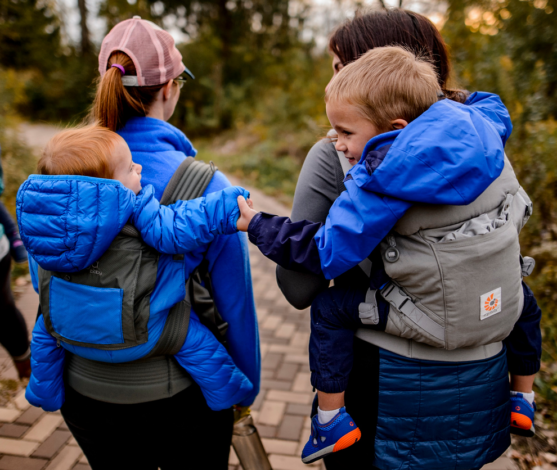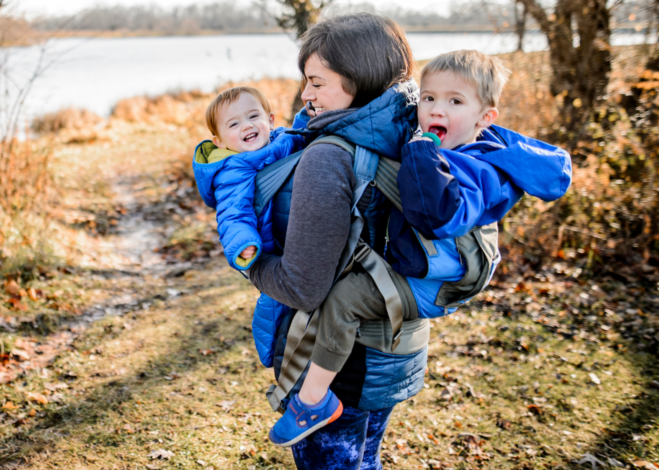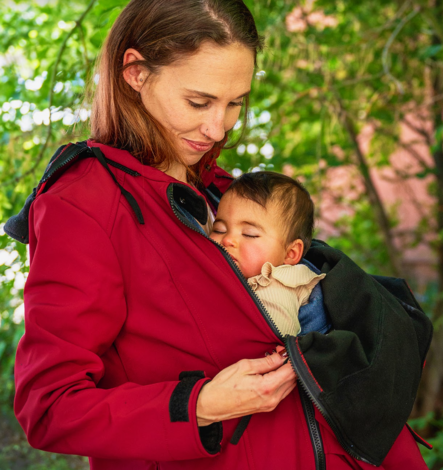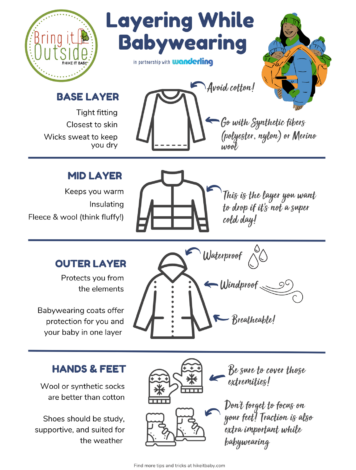Layering for Babywearing in the Winter
Created in partnership with our friends at 
With so much focus on how to dress baby in the winter, we often forget that babywearing parents need to stay, warm, dry and cozy too! It’s important to remember that you and baby both need to maintain a normal body temperature, so you want to avoid those extremes causing you to be too cold or sweat too much. Too much clothing plus carrying a baby can make you extra toasty, and too little clothing can leave you ready to cut your outdoor adventures short. The solution? Layers! Here are some tips to keep you layered and feeling just right on your outdoor adventures this winter.

Start with a base layer for you and the baby, ideally something made of synthetic or wool fibers, avoiding cotton if possible. Cotton will trap moisture against your skin and causes that sweaty situation we want to avoid! For a mid-layer, stick with thick knit wool, a down insulated layer insulated or something like polyester fleece or other synthetic insulation. This is a great layer to include if it’s really frigid out, but this would likely be the layer you want to lose if it’s just cool.

The outer layer can be a tough one! Too puffy a layer makes getting your carrier on difficult, and too thin a layer can leave you feeling chilly. Generally you will want a weather-resistant outer layer that can stand up to low temperatures along with possible precipitation and wind. How “weather-resistant” this layer needs to be will depend on the expected conditions. A good option to keep you and the baby covered would be a babywearing coat. This provides a top layer for you and your little one, and can cover you both in either back or front carry positions. Learn more about one of our favorite options for keeping cozy from Wanderling here!

In addition to those basic layers, adults need to keep those extremities warm and dry too. When temperatures are low, our bodies focus on keeping most of our warmth in toward our core to keep us safe. While this is essential, it can certainly get uncomfortable for our extremities so good-quality hats, gloves/mittens, socks, scarves, etc., are important. As with our body layers, it is best to stick with wicking wool or synthetic materials here, since wet feet and hands will feel icy cold in low temperatures. In terms of footwear, traction and warmth are key, especially while babywearing. If you live in a location that sees snow and rain, you will want waterproofing as well. You can also print out this handy resource for layering!
Some important points to remember about babywearing in the cold is that your carrier counts as a layer for your little one, so if you are using a wrap with multiple passes that would count as multiple layers. Also, your layers for the little one would depend not only on the temperature outdoors, but the age of your baby. If they are in and out of the carrier and moving around on their own, then you might find they need a more waterproof layer than a warm one. With these tips in mind, we hope you enjoy your outdoor adventures with your little one all winter long!
What winter weather layering tips do you have for babywearing?
ABOUT OUTGROWN
OutGrown is a 501(c)(3) nonprofit that works to create a world where everyone can enjoy the physical and mental benefits of spending time outside. We are focused on creating opportunities and removing barriers to access so families with babies and young children can take their first steps outside. We believe all families have the right to connect with nature, benefit from spending time outdoors and be inspired to a lifelong love of nature. Since its grassroots inception in 2013, OutGrown is a growing community of 280,000 families and over 300 volunteer Branch Ambassadors. More information on all of our programs can be found at WeAreOutGrown.org
EDITORS NOTE:
We hope you enjoyed reading this article from OutGrown. We’re working hard to provide our community with content and resources that inform, inspire, and entertain you.
But content is not free. It’s built on the hard work and dedication of writers, editors, and volunteers. We make an investment in developing premium content to make it easier for families with young children to connect with nature and each other. We do not ask this lightly, but if you can, please make a contribution and help us extend our reach
Related Content






Comments